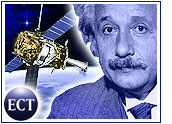
Those wanting to represent the Internet graphically to a lay audience are fond of animations showing a spinning Earth criss-crossed by a network of buzzing, vibrating lines. Lift those animations up from the planet a bit, and you get a picture of what space someday could become — a place where common Internet protocols are the norm for information exchange.
Astronauts and cosmonauts are not likely to do their online holiday shopping from Earth orbit soon. But on its final mission, in the days preceding its fatal plunge on February 1, 2003, the Space Shuttle Columbia carried out a set of successful experiments and demonstrations showing the practicality of using the Internet in space. The “Internet” in this case is not the global Internet you and I know; it is NASA’s very own province, called IONet, which is currently isolated from the Internet at large but uses the same protocols as the Internet.
The Communications and Navigation Demonstration on Shuttle (CANDOS) project used a new low-power transceiver (LPT) on the shuttle to communicate with bases in New Mexico, Virginia and Florida. This LPT, and its several antennas, also were being tested as part of the experimental setup.
Columbia carried an off-the-shelf PC running Red Hat Linux 6.1 with an unmodified IP stack. The addition of Cisco 2621 routers and ground-station interface devices completed the elements of the hardware setup.
Cost, Simplicity and Reliability
Why extend the Internet to space? We’ve lived without it so far.
The benefits in cost, simplicity and reliability are clear, according to CANDOS chief investigator David Israel, who oversaw both the LPT and the IP parts of the project. “Until recently, in order to communicate [with an experiment in space], there’d be specialized custom hardware needed,” he told TechNewsWorld.
“In the IP-based world, you can have an experiment and plug it into your office LAN and talk directly to and from your experiment [in space] without specialized equipment; it makes testing and integration a whole lot easier and cheaper.”
Eventually, he said, it will allow researchers to deploy tools more powerfully and flexibly than before.
First Steps
Of course, this mission didn’t materialize out of thin air. It was the culmination of a series of projects stretching back half a decade. Back in 1997, the South Pole research station got Internet access via NASA’s Tracking and Data Relay Satellite System (TDRSS).
By April 2000, NASA engineers on the ground had successfully pinged the UoSAT-12 satellite in orbit — that is, they were able to send a packet of Internet data to and from the satellite successfully. In fact, when launched the year before, the satellite’s 386-based computer carried no Internet Protocol support; that was uploaded later.
A few days later, with the same end-to-end IP connectivity, UoSAT’s onboard clock was synchronized to a source on Earth using the Network Time Protocol, the first time this had ever been done.
The following month, the same satellite was used for the first fully compliant FTP session and file transfer, and in January 2001 it became the first Web server in space, using HTTP to transfer real-time telemetry and stored instrument data directly from the spacecraft to Earth.
In January 2003, NASA launched CHIPsat, the first operational NASA mission designed from the ground up to use Internet protocols exclusively for all of its communication links. Four days later, shuttle mission STS-107 lifted off carrying the CANDOS project.
Columbia Payload
While the flight equipment was carried as a payload on Columbia, its activities were scheduled and carried out as if it were on a free-flying satellite like its predecessors. A wide variety of tasks — 134 in all — were carried out using normal IP formats.
Use of IP addressing meant that all the bases on the ground could communicate with the orbiting transceiver by knowing just its single mobile IP address: The system reconfigured data paths as the Shuttle moved around the Earth and “handed off” the transmission automatically to the next node in line.
The tests and demonstrations fell into three categories: commanding, file delivery and telemetry. The spaceship was controlled from the ground with a “blind command” (that is, without telemetry) using the User Datagram Protocol (UDP). Stored command files were uploaded using Multicast Dissemination Protocol (MDP) and the Secure Copy Protocol (SCP) which, with Secure Shell Protocol (SSH), allowed the signal to be secure with encryption.
Data files were uploaded and downloaded via MDP and FTP, but it wasn’t all just about science and technology. In an effort to stimulate public interest, NASA arranged for schools to upload class photos and student artwork, which spent a day in orbit.
Success, Then Tragedy
The CANDOS experiments worked very well. “After the years of putting it all together and knowing all the things that could go wrong, it went better than I’d hoped it would,” said Israel. “I went to sleep that Friday night exhausted but real happy and satisfied.” And then, he said, referring to the loss of Columbia, “on Saturday morning the whole world changed.”
We are, he observed, in a transitional stage, with IP-in-space technology just starting to move beyond the R&D phase into practical use. As the systems prove themselves, NASA will take on more ambitious linkages. Space vehicles, manned and unmanned, will use IP to communicate with each other as well as the ground-control centers.
In one research project, a satellite detecting a gamma-ray burst — a short-duration event of great interest to scientists — could quickly and automatically reorient other satellites with different instruments to observe the same point in the sky.
Now cast your imagination forward a generation to a time when suborbital passenger space flights are a reality and high-flying intercontinental passengers enjoy in-flight e-mailing and Web browsing as they sip their champagne, just as business travelers are starting to do at 30,000 feet today.
Once the stuff of fantasy, today, given the success of NASA’s CANDOS project, this vision easily could materialize into reality.
The fourth in a series of NASA Space Internet Workshops will be held in June 2004 in Hanover, Maryland.





















































That Dave Israel rocks! He sent a jpg of one of my paintings (a self portrait of me walking my dog) into space. I will forever be indebted. It’s the closest that either I or Bob the dog will come to space travel. He even gave me a foam rubber replica of the transceiver! How cool is that??!!